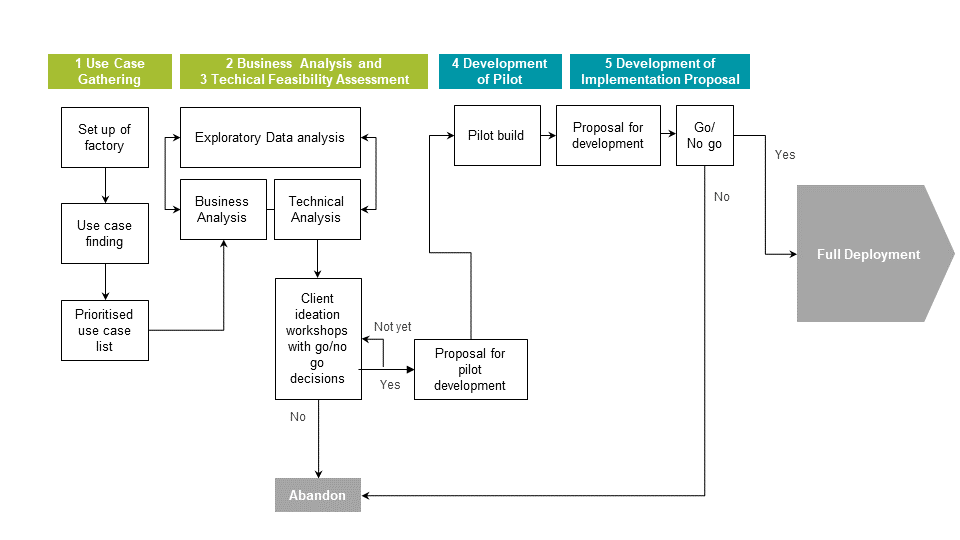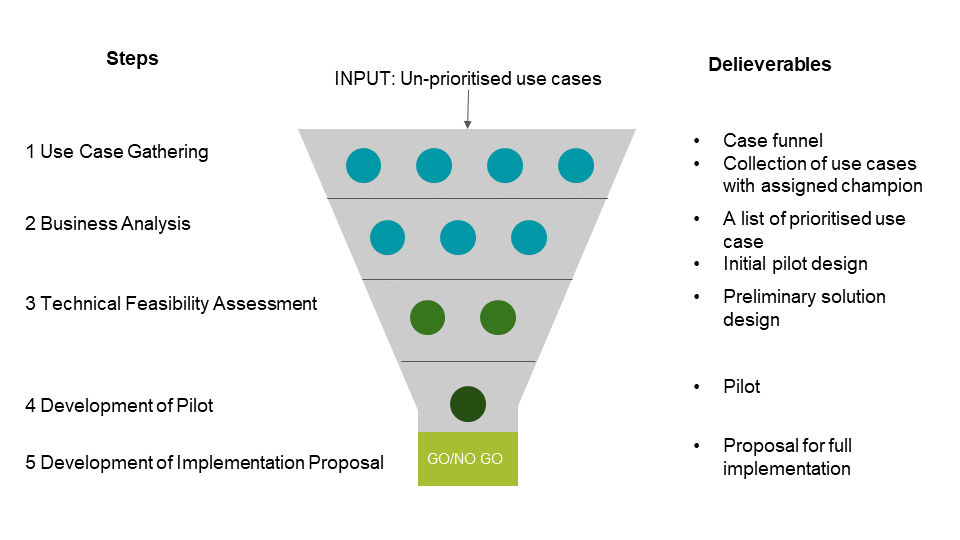The pandemic has made the need for organisations to digitise and increase technology adoption even more urgent. More and more companies are turning to artificial intelligence for help in their processes. But how can managers ensure that they go about it in the most effective way possible? Terence Tse, Dilpreet Sall, Mark Esposito and Danny Goh created a five-step methodology to improve the odds of success in AI adoption.
It’s really unsurprising to see the pandemic has driven many companies to redouble their digital transformation efforts, with automating costly labour-intensive processes as a key immediate initiative. Among the different routes to automation, an increasing number of businesses is looking at artificial intelligence (AI) to help. While the media are more attracted by the shiny benefits brought by the latest AI technology, getting value out of it demands more than just understanding how it works.
Why pilots don’t always succeed
The beginning to a full AI solution is often establishing a proof of concept or pilot project. Yet, many of these first attempts end up in failure. Why? One reason is simply picking the wrong opportunities for first tries. Modern companies’ processes are often complex, thereby offering many possibilities for automation. But which one to work on? Placing bets on the wrong cases is essentially setting up for failure.
To complicate matters further, even with the opportunities with the greatest potential identified, pilots can easily get stuck in the planning stage. IT teams often face pressure to ensure initial pilot projects succeed to be able to secure funding for full implementation later. While such financial prudence is commendable, it can lead the teams to spend months on planning a pilot. They would be better served by getting started with testing the feasibility of the technology.
But sometimes even if IT teams manage to get the pilot launched and the technical feasibility conducted shows promise, they are set back by many unforeseen challenges that emerge along the way to implementation that add integration complexities, incur high maintenance costs and demand excessive business process reengineering.
Five steps to increase your chance of success
But much of this can be simplified or avoided with the right approach. From our client experience, there exists a five-step methodology – we called it “AI Factory” – to significantly improve the probability of success in locating and building the pilot projects with the greatest potential benefits when implemented business-wide. To better illustrate AI Factory, we use an ongoing engagement with a UK government agency. The pandemic has put enormous pressure on the bulk of the agency’s manually run operations. It needs to identify and develop the right automation solutions fast. For the agency, it is not just a matter to ensure the current operations can sustain; it is also about scaling up as service demand goes up.
Figure 1. AI Factory (click for larger view)
Step 1: The start of the journey is to collect all the possible use cases. This is best done in conjunction with building a holistic view of the organisation. For instance, in the case of our UK agency client, the amount of data and the strategy it has got as well as the imminent needs and process bottlenecks have all been taken into considerations.
Also note that a “business first” mindset takes priority when it is possible to see how the use cases are attributable to the overall benefits of the company. It is also a good practice to gather as many use cases as possible without preclusion. This is because a use case will be subsequently assessed based not just on the business merit; how tricky and risky it is to deploy AI technologies also plays an important role.
The total number of use cases can be overwhelming – our client has got more than 100. As can be imagined, it will be impossible to run a pilot for all of them. Therefore, they must be first prioritized against of set criteria before making it into a “case funnel” for consideration in the next step.
Figure 2. Detailed process in the AI Factory (click for larger view)
Step 2: A more in-depth business analysis is then undertaken for each of the chosen use cases following a framework called “NAFTA”. They include:
Need: Does the use case solve or contribute to a core need of the business?
Alignment: Does the use case align with the long-term strategic vision of the company?
Finances: How will the cost & benefits be decided based on the specific use case?
Technological complexity: How complicated is it to design and implement the AI model?
Assessment: What are the model deployment and model failure risks and is there a suitable mitigation strategy?
A key performance indicator to successful adoption of technology is the return on investment. We estimate it by using a tool developed based on our experience, taking into account not just the costs and benefits of the technologies when embedded in a company’s operations; it also considers that of that related to workflow changes and people issues.
Step 3: At this stage, the cases are evaluated for their technical merits. This is done by carrying out small experiments to showcase what the AI technology can (and cannot) do. Where applicable, a comparison of different solutions – off-the-shelf, open source and bespoke – is held. This ensures that technical analysis works in favour of the client as it considers all available alternatives and not just custom-made ones. Step 3 is critical to produce insight into the technology without a large upfront time and capital investment.
The deliverable for this stage is, for each use case, a recommendations report that combines the findings from both the business and technical feasibility analyses. The report also contains a preliminary solution design and architecture suggestions on how to move the case to the development phase. The promising ones will then make it to the next step.
Step 4: A pilot project is developed for each of the selected use cases, turning perceived benefits into first tangible results. These results are then presented to the company for feedback, which in turn inform further improvements to the pilot. This cycle goes on until the pilot meets the success criteria established by the business.
Step 5: The final step is coming up with a full implementation plan based on the learnings from the pilot study. Initially, the draft plan is presented to the business to elicit various possibilities to help accelerate the delivery as well as turn the pilot into a full-scale solution smoothly and quickly. With the full implementation plan, the business will be in the best position to decide whether to pursue the AI solution or not.
Home run
The benefits from an AI Factory-generated plan are clear: companies have a much higher chance of getting the right solution for the right opportunity. Moreover, they can often put together a workable full implementation plan at a speed previously unachievable.
For our client, by following these steps, we were able to produce the full implementation plan of four use cases including integration plans and accurate costing evidenced by pilot project results – all within a matter of three months. These implementation plans are expected to help the government agency to accelerate their efforts to automate its process by 60 per cent.
In addition, education and knowledge building play an important part of AI Factory. Along with pilot development, we organize leadership training sessions to provide insights and goal setting for the senior executive team to make sure that it is equipped to start the journey to AI automation. Indeed, by getting the team members involved from the very beginning, they are to become more knowledgeable in AI overtime and better able to provide valuable feedback for pilot development.
One must remember that deploying AI is as much a technology project as a business one. Therefore, to improve the odds of getting the use of AI technologies right, companies must think through all considerations, both business and technological, carefully and speedily. With the pandemic fuelling the urgency for digital transformation, companies are in a rush to tech themselves out in a short time span. Those that have got the best frameworks and methodologies to do so are likely to have the best chance of success in the future.
♣♣♣
Notes:
- The post expresses the views of its authors, and do not necessarily represent those of LSE Business Review or the London School of Economics.
- Featured image by geralt, under a Pixabay licence
- When you leave a comment, you’re agreeing to our Comment Policy






